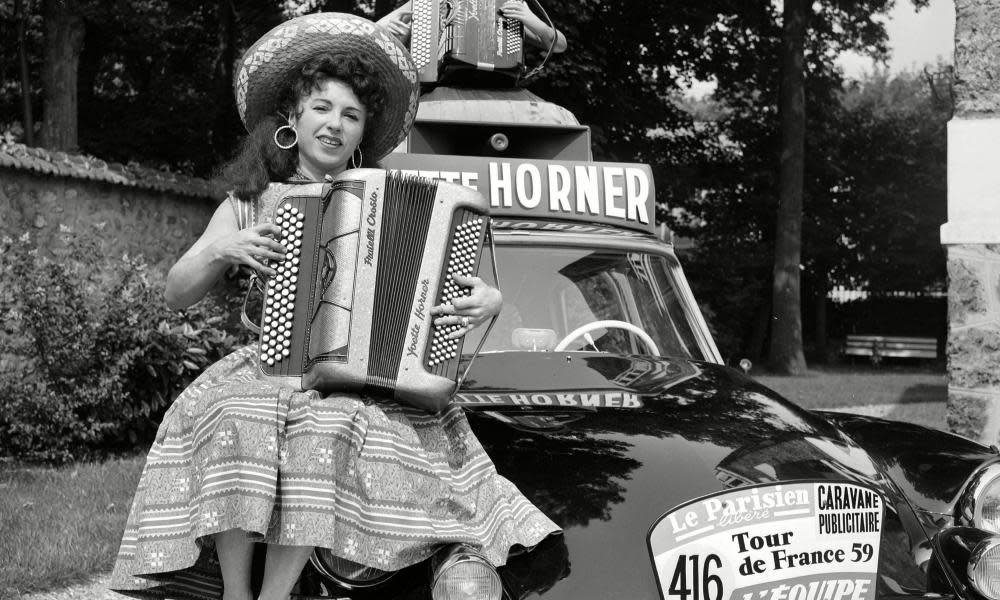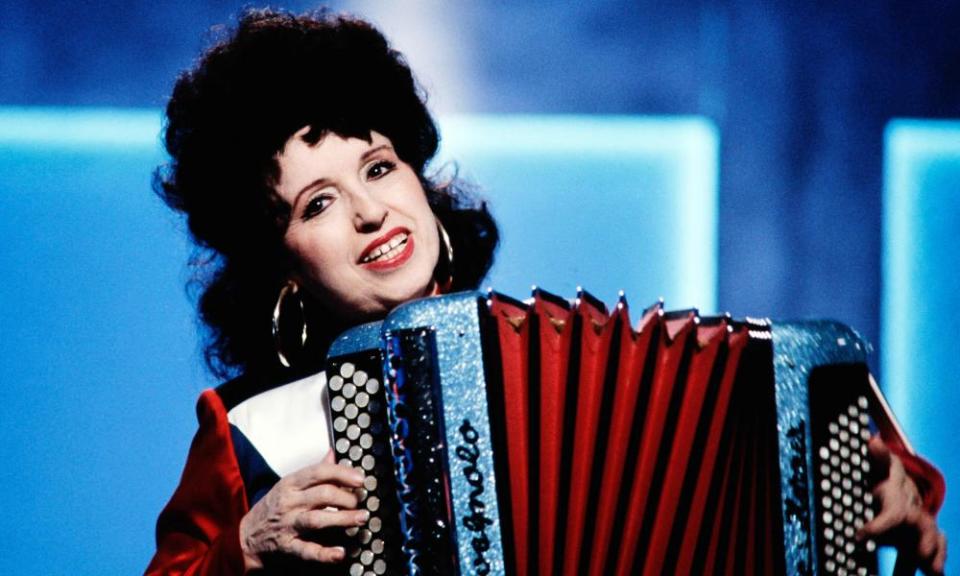Yvette Horner obituary

The name of the accordion player Yvette Horner, who has died aged 95, is synonymous with the golden years of the Tour de France, from 1950 until 1965. While it was (usually French) men at the heart of the narrative of the summer soap opera – Louison Bobet, Raymond Poulidor and Jacques Anquetil – related by writers such as Antoine Blondin, it was Horner who created the soundtrack of light-hearted music that set the mood on the roads of France.
It said much about the chauvinistic nature of the Tour that one of the few women allowed to travel with the race spent her days at the head of the publicity caravan, sitting on top of a Citroën Traction Avant plunking at her accordion for up to seven hours a day, in all weathers. That was just part of a playing career that encompassed 64 years, 2,000 concerts, 150 albums and – so she said – 30m records sold in France.
Horner was born in Tarbes, south-west France, where her maternal grandparents ran the Italianate Théatre Impérial. Her father, Louis Hornère, was a building contractor. Yvette trained as a classical pianist but was made to switch to the accordion by her mother, who sensed a commercial opportunity (and encouraged her to change her surname to Horner). “I cried for three years,” she recalled. At 26, she won the World Accordionist Federation’s world cup in Lausanne, the first woman to do so. She was a versatile player, as at home playing Bach or free-form jazz as with the popular airs of the time.

Initially, she played in cinemas and casinos, but her breakthrough came in 1952 when the Calor company, which made electric irons, suggested she travel with them in the Tour de France’s publicity caravan. “I stood on the roof [of the car], leaning on the seat, strapped in, with an instrument weighing almost 15kg,” she recalled. “I played all along the course, without stopping on the mountain climbs or the descents. Sometimes I had to take mosquitos out of my nose, sometimes I was grubbier than the stage winner, and when it rained I had only a hat.” When she was completely worn out, she would put a life-size model of herself on the car roof (it was auctioned off for 2,200 euros in 2005) – until the crowds cottoned on.
In the evenings, after attempting to find something to eat “in a bar on a back road” to avoid crowds – and drying out the keys of the accordion if it had been raining and they had begun to stick – she would play again in the centre of the stage town until 2am. The alarm would ring at 6am and she would be back on the road again, driven by her husband, the former Bordeaux Girondins soccer player René Dresch, who had quit his career to support her. Dresch died in 1986; Horner often expressed her regret that the marriage produced no children.

Horner left the Tour in 1965 – conscious that accordion music was about to be overtaken by rock – but her contacts with the bike race lingered: when she sold her millionth record, Anquetil came to celebrate; later, she played for him at a celebratory evening at his home village in Normandy, the kind of local bal musette where the accordion was de rigueur. She had bought a house in the Paris suburb of Nogent-sur-Marne, which was reported to be accordion-themed from top to bottom; in Nogent, she was seen replicating her Tour act on top of a lorry during the Fete du Petit Vin Blanc.
Late in her career, she became something of a national treasure with a slightly camp edge, playing at the Bastille on 14 July 1989 in a red, white and blue dress with the national jazz orchestra to celebrate the 200th anniversary of the revolution. She appeared on the TV rock show Taratata, duetting with Boy George on Gershwin’s Summertime, collaborated with the choreographer Maurice Béjart, and was seen in a revue at the Casino de Paris, dressed by Jean-Paul Gaultier, who was to design the sleeve of her final album, Hors Norme (2012).
Her memoirs, Le Biscuit dans la Poche, were published in 2005; towards the end of her life a square in her home town of Tarbes was named after her, and she was made a member of the Légion d’Honneur.
• Yvette Horner (Yvette Hornère), accordionist, born 22 September 1922; died 11 June 2018

 Yahoo News
Yahoo News 
